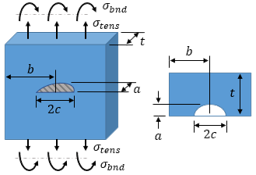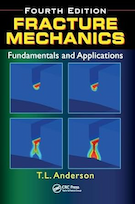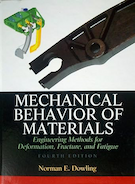Introduction to Fracture Mechanics
This page provides the front matter, contents, and references from Wang, C. H. "Introduction to Fracture Mechanics," DSTO Aeronautical and Maritime Research Laboratory, DSTO-GD-0103, 1996.
Other related chapters from "Introduction to Fracture Mechanics" can be seen to the right.
- Introduction to Fracture Mechanics
- Fracture Mechanics Fundamentals
- Energy Concepts for Crack Growth
- Stress Intensity Factor
- Plastic Yielding at Crack Tip
- Fracture Criteria
- Fatigue Crack Growth
Abstract
This text is based on a series of lectures conducted on fracture mechanics. As an introductory course, the text is focused on the essential concepts and analytical methods of fracture mechanics, aiming at painting a broad picture of the theoretical background to fracture mechanics. While a brief review of some important issues in the theory of elasticity is provided in the first chapter, the main focus of the test is centred on stress analysis and energetic approaches to cracked components, local plastic deformation at crack tips, fracture criteria and fatigue life prediction.
Executive Summary
This text is prepared for a series of lectures on fracture mechanics. The main aim of the lectures is to provide AMRL staff who are involved in aircraft fatigue and fracture research with a broad picture of the theoretical background to fracture mechanics via a stress analysis viewpoint.
As an introductory course, the lectures are focused on the essential concepts and analytical methods of fracture mechanics. A brief review of some important issues in the theory of elasticity is provided in Chapter 1, while the remaining chapters deal with the stress analysis approach and the energy approach to cracked components, local plastic deformation at crack tips, fracture criteria and fatigue life prediction.
About the Author
C. H. Wang
Airframe and Engine Division
Chun-Hui Wang has a B.Eng and Ph.D (Sheffield, UK) in Mechanical Engineering and is currently a member of the Institute of Engineers, Australia. Prior to joining the Aeronautical and Maritime Research Laboratory in 1995 as a Senior Research Scientist, Dr. Wang was a Lecturer at the Deakin University. He has an extensive research record in fatigue and fracture mechanics, stress analysis and constitutive modelling, and biomechanics. Over the last six years he also held academic/research positions at the University of Sydney and the University of Sheffield, UK.
1. Fundamentals
This chapter is located here: Fracture Mechanics Fundamentals.
2. Stress Analysis of Cracked Components
Energy Concepts for Crack Growth
These sections are located here: Energy Concepts for Crack Growth.
Stress Intensity Factor
These sections are located here: Stress Intensity Factor.
3. Plastic Yielding at Crack Tip
This chapter is located here: Plastic Yielding at Crack Tip.
4. Fracture Criteria
This chapter is located here: Fracture Criteria.
5. Fatigue and Life Prediction
This chapter is located here: Fatigue Crack Growth.
6. References
- Anderson, T. L. (1995) Fracture Mechanics, fundamentals and applications, CRC Press, Boca Raton.
- Barenblatt, G. I. (1962) The mathematical theory of equilibrium cracks in brittle fracture, Advances in Applied Mechanics, Vol. VII, Academic Press, 55-129.
- Battelle Columbus Laboratories (1983) Damage Tolerant Design Handbook, MCIC-HB-O1R, Metals and Ceramics Information Centre, USA.
- Bowie, O. L. (1956) Analysis of an infinite plate containing radial cracks originating at the boundary of an internal circular hole, J. Math. Phys., Vol. XXXV, No.1, 60-71.
- Broek, D. (1986) Elementary Engineering Fracture Mechanics, Kluwer Academic Publishers, Dordrecht.
- Broek, D. (1989) The Practical Use of Fracture Mechanics, Kluwer Academic Publishers, Dordrecht.
- Dugdale, D. S. (1962) Yielding in steel sheets containing slits, Journal of Mechanics and Physics of Solids, Vol. 8, 100-104.
- Elber, W. (1971) The significance of fatigue crack closure, in Damage Tolerance in Aircraft Structures, American Society for Testing Materials, Philadelphia, USA, ASTM STP 486, pp.230-243.
- Inglis, C. E. (1913) Stresses in a plate due to the presence of cracks and sharp corners, Trans. Instn. Naval Archit. 55, 219.
- Lawn, B. R. and Wilshaw, T. R. (1975) Fracture of Brittle Solids, Cambridge University Press, Cambridge.
- Murakami, Y. (Editor) (1987) Stress Intensity Factors Handbook, Pergamon Press.
- Muskhelishvili, N. I. (1953) Some Basic Problems of the Mathematical Theory of Elasticity, Groningen, P. Noordhoff Ltd.
- Newman, J. C. Jr. (1992) FASTRAN-II - A fatigue crack growth structural analysis program, NASA Technical Memorandum, 104159.
- Newman, J. C. Jr. (1995) Fatigue-life prediction methodology using a crack closure model, J. Engineering Materials and Technology, Vol.117, 433-439.
- Rice, J. R. (1968) "A path independent integral and the approximate analysis of strain concentration by notches and cracks", Journal of Applied Mechanics, Vol.35, 379-386.
- Timoshenko, S. P. and Goodier, J. N. (1970) Theory of Elasticity, Third Edition, McGraw-Hill.
- Westgaard, H. M. (1939) Bearing pressures and cracks, J. Appl. Mech. Vol.10, 77.
- Wheeler, O. E. (1972) Spectrum loading and crack growth, Journal of Basic Engineering, Vol.94, 181-186.



